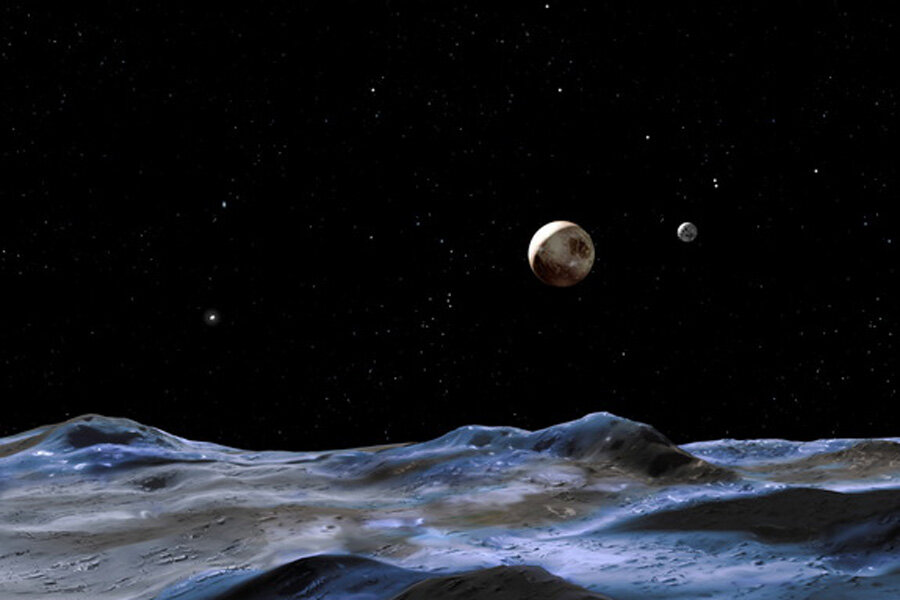Pluto's largest moon may have once harbored subsurface ocean, say scientists
Loading...
A NASA mission arriving in the Pluto system next year could help scientists figure out if the dwarf planet's largest moon Charon might have once harbored a subsurface ocean of liquid water.
Researchers think it's possible that the icy surface of Charon — Pluto's largest moon — is cracked, which could, in turn, mean that its interior was once warm enough to support an ocean, NASA officials said. Two frigid moons with cracks, Saturn's Enceladus and Jupiter's Europa, have underground oceans beneath their icy shells. It's possible that Charon resembled those two moons sometime in the past.
Charon probably cannot support a liquid ocean today. However, friction created by tidal forces earlier in the solar system's history could have warmed Charon's interior. NASA's New Horizons mission, scheduled to reach Pluto and its moons in 2015, could help scientists learn if Charon was cracked and even wet in its early days. [See photos of Pluto and its moons]
"Our model predicts different fracture patterns on the surface of Charon depending on the thickness of its surface ice, the structure of the moon's interior and how easily it deforms, and how its orbit evolved," Alyssa Rhoden of NASA's Goddard Space Flight Center in Greenbelt, Maryland, said in a statement. "By comparing the actual New Horizons observations of Charon to the various predictions, we can see what fits best and discover if Charon could have had a subsurface ocean in its past, driven by high eccentricity."
At the moment, Charon is extremely cold like Pluto — the dwarf planet's surface temperatures are expected to be around minus 380 degrees Fahrenheit (minus 229 degrees Celsius).
Scientists think that the tidal forces that warmed the interior of the moon could have been created if Charon had a very eccentric orbit sometime in the past. The forces would have caused telltale cracks in the moon's surface.
Charon probably formed after a huge impact blasted pieces of Pluto off into space. Those pieces orbited Pluto, eventually coalescing into the moons, NASA officials said. At the moment, scientists have discovered four other moons orbiting the dwarf planet.
"Initially, there would have been strong tides on both worlds as gravity between Pluto and Charon caused their surfaces to bulge toward each other, generating friction in their interiors," NASA officials said in a statement. "This friction would have also caused the tides to slightly lag behind their orbital positions. The lag would act like a brake on Pluto, causing its rotation to slow while transferring that rotational energy to Charon, making it speed up and move farther away from Pluto."
The moon's orbit around Pluto is very circular now, making it unlikely that Charon is still harboring a liquid ocean, Rhoden said. If Charon does have fractures — surface features that are relatively easy to get, according to Rhoden — it would help scientists learn a little more about the early history of the moon and Pluto's interactions with it.
"Since it's so easy to get fractures, if we get to Charon and there are none, it puts a very strong constraint on how high the eccentricity could have been and how warm the interior ever could have been," Rhoden said. "This research gives us a head start on the New Horizons arrival — what should we look for and what can we learn from it. We're going to Pluto and Pluto is fascinating, but Charon is also going to be fascinating."
Follow Miriam Kramer @mirikramer and Google+. Follow us @Spacedotcom, Facebook and Google+. Original article on Space.com.
- Pluto's 5 Moons Explained: How They Measure Up (Infographic)
- Pluto Quiz: How Well Do You Know the Dwarf Planet?
- Inside Dwarf Planet Pluto
Copyright 2014 SPACE.com, a TechMediaNetwork company. All rights reserved. This material may not be published, broadcast, rewritten or redistributed.







